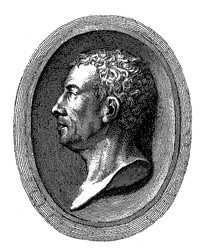Der bärtige, durch die phrygische Mütze als "Barbar" gekennzeichnete König Priamos kniet rechts im Bild vor Achill nieder und bittet um die Herausgabe des Leichnams seines Sohnes Hektor. Achill, in "heroischer" Nacktheit nur mit einem Manteltuch bekleidet, sitzt auf einem Stuhl und wendet sich mit pathetischem Gestus von Priamos ab. Im Hintergrund ein Tisch mit Krug und Früchten sowie ein Leuchter vor Wandvorhängen.
Buonaventura Genelli schuf in seiner Münchener Zeit von 1832 bis 1859 die Umrisszeichnungen zu Homer in 48 Blättern, die später, u.a. von Hermann Schütz, gestochen wurden.
Schenkung Dr. Axel Rügler
Bez.:
u.m.: B. Genelli inv et fc
Titel darunter: Ilias. Gesang 24, Vers 486
en

